Uphill climb
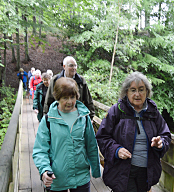
Bridge crossing
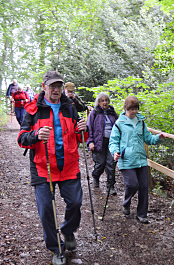
Bob Jarmson leads us down the hill 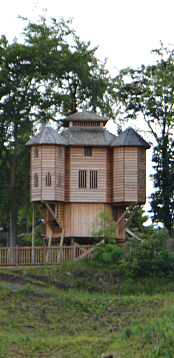
Fort Douglas

Lunch at the Laundry house
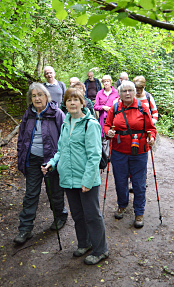
Now is this the way?
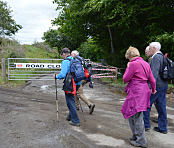
No - Road Closed. Try this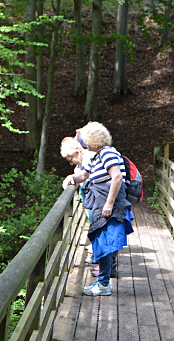
Don't jump cries Dorothy.
Not worth it!.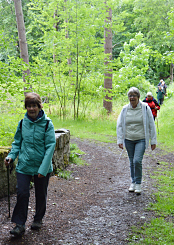
Carol and the white trainers
|
| | | Sponsored
Walk - Saturday 10 June 2017 |
Report and Photos - Jim Paterson.
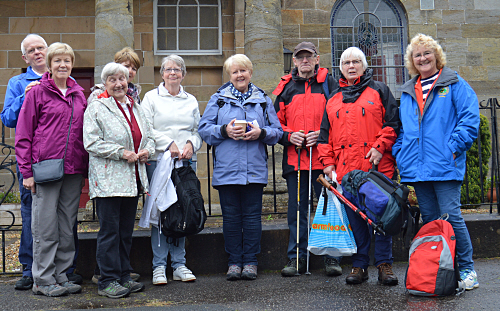
Our group of walkers outside St. Mungo's
The
walkers gathered at St. Mungo's on the morning of Saturday 10th June,
just as a downpour commenced. Did we really want to do this? echoed
around the vestibule as we huddled for shelter, dripping on the floor!
By time the preliminaries were covered the rain had stopped. Someone
looking down kindly on us poor souls? As you see the photo in front of
the church as we prepared to depart shows how quickly the weather 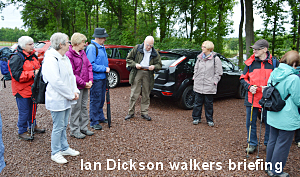 changes in Scotland, supporting the old adage, 'if you don't like the weather in Scotland, wait 5 minutes! changes in Scotland, supporting the old adage, 'if you don't like the weather in Scotland, wait 5 minutes!
This
years walk was around Dalkeith Country Park, last visited on a walk
back in 2014. We met up with friends from Roslin, that we see often on
these walks. The park has changed a lot in the past four years, with
more facilities for families with young children, walkers and cyclists.
Kitted up we set off, still keeping a close grip on our
waterproofs, just in case. We headed across the cycle practice area
back on to the 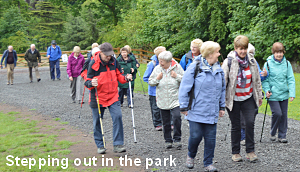 path
heading for the Kings Gate, which offered great views of Dalkeith
Palace. Completed in 1711, and designed for the Earl of Buccleuch by
Scottish architect James Smith, who used William of Orange's
Palace of Het Loo in the Netherlands as a model. It is built on the
site of an earlier Dalkeith Castle dating back to the 12th century.
Smith incorporated a portion of the tower house of the old castle into
the western side of the new structure, of which the outline of the old
tower walls is still visible in the western facade of the palace today. path
heading for the Kings Gate, which offered great views of Dalkeith
Palace. Completed in 1711, and designed for the Earl of Buccleuch by
Scottish architect James Smith, who used William of Orange's
Palace of Het Loo in the Netherlands as a model. It is built on the
site of an earlier Dalkeith Castle dating back to the 12th century.
Smith incorporated a portion of the tower house of the old castle into
the western side of the new structure, of which the outline of the old
tower walls is still visible in the western facade of the palace today.
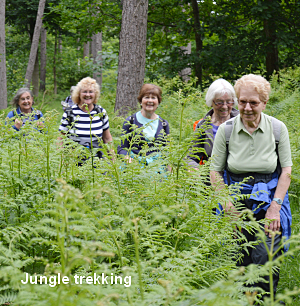 We
crossed Montagu Bridge. This Robert Adam designed bridge built in 1792
crosses the North Esk River connecting Dalkeith Palace with the main
Edinburgh road, (Kings Gate) and shows how important the example of
ancient Rome remained in eighteenth-century Scotland. Its monumental
scale recalls the magnificence of Roman bridges and aqueducts, while
its elaborate surface decoration derives from the great temples and
bathhouses built by the emperors for the Roman people. Although built
in simpler form than Adam originally intended, it remains an
astonishing testimony to the architect’s ability to adapt ancient
forms to the needs of eighteenth-century clients. We
crossed Montagu Bridge. This Robert Adam designed bridge built in 1792
crosses the North Esk River connecting Dalkeith Palace with the main
Edinburgh road, (Kings Gate) and shows how important the example of
ancient Rome remained in eighteenth-century Scotland. Its monumental
scale recalls the magnificence of Roman bridges and aqueducts, while
its elaborate surface decoration derives from the great temples and
bathhouses built by the emperors for the Roman people. Although built
in simpler form than Adam originally intended, it remains an
astonishing testimony to the architect’s ability to adapt ancient
forms to the needs of eighteenth-century clients.
We swung off
the road into Lugton Haugh, through thick tree cover, some still
dripping the raindrops they had captured earlier. This led to Westgate
Park, where we took care on the sometimes slippy paths, especially
those that were 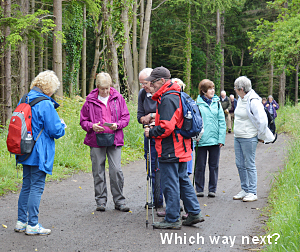 narrow
and muddy. Carol Lough began to wish she had not come in white
trainers! We arrived nearer the Kings Gate to cross the road and walk
into The Belwoods woodland. By now the weather was drying well and the
trees stopped showering us. narrow
and muddy. Carol Lough began to wish she had not come in white
trainers! We arrived nearer the Kings Gate to cross the road and walk
into The Belwoods woodland. By now the weather was drying well and the
trees stopped showering us.
Following the route, uphill and
down dale, following the North Esk River we reached the 'Meeting of the
Waters' where the north and South Esk rivers join to form the River Esk
heading to the sea. We were now in the 'Old Wood' . These woodlands are
hundreds of years old and now a Site of Special Scientific Interest
(SSSI) with some trees over 900 years of age, allegedly planted by
monks from nearby Newbattle perhaps? Some are gnarled and broken but
still hanging on, the trees that is, not the monks!. The park
management realised a few years ago that because of the livestock that
lives in the oak wood, very few seedlings were growing and the
wood would one day die out. So they've planted seedlings in protected
positions, putting fences round them to protect them from the cattle
and rabbits.
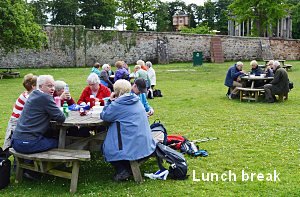 From
the Old Wood we passed through Steel Park to emerge at the picnic area
in front of the Georgian Laundry room. The rest was well received
and we saw the fabulous Orangerie, designed by William Burn in
1832, and recently refurbished. It was intended to grow exotic fruits
for the Duke at Dalkeith Palace, heated by an under-floor boiler, with
the chimney reaching up through its centre. From
the Old Wood we passed through Steel Park to emerge at the picnic area
in front of the Georgian Laundry room. The rest was well received
and we saw the fabulous Orangerie, designed by William Burn in
1832, and recently refurbished. It was intended to grow exotic fruits
for the Duke at Dalkeith Palace, heated by an under-floor boiler, with
the chimney reaching up through its centre.
More modern for the
younger at heart is Fort Douglas, what we would call a tree house. This
one is far more ambitious and a great hit with the kids.
Refreshed
we headed off on our second stage, crossing the 1740 William Adam
designed Laundry Bridge over the Esk. The extended route took us
on asphalt roads this time past Sandyriggs Wood to cross the bridge
over the A68, passing Cecil's Field, home to a few horses from the
nearby Equestrian Centre. Crossing the River Esk at Smeaton Bridge we
walked back along the riverside the 'Meeting of the Waters' to find
those who had taken a shorter route.
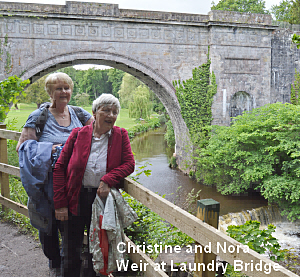 Reunited
we made our final stage of the day to Restoration Yard, based in the
converted Stables and Coach-house were designed in 1740 by William Adam
with additions in 1840 by William Burn, who added the famous clock
tower and belfry. Reunited
we made our final stage of the day to Restoration Yard, based in the
converted Stables and Coach-house were designed in 1740 by William Adam
with additions in 1840 by William Burn, who added the famous clock
tower and belfry.
Our
final farewells to our friends from Roslin complete we all headed home
to Penicuik. An excited in somewhat tired team of walkers, we had
crossed some magnificent countryside, in many cases walking
through history. So you see, our sponsored walks not only
exercise your body, but provide your mind with amazing historical facts
in the countryside right on our doorstep. Our thanks to Ian and Moira
Dickson who planned this walk for us. Join us next year when Ian and
Moira will once again take us to another walk that will open your eyes.
The
sponsored walk raised £1074, the highest ever from these walks,
and helps to fund the upkeep of our church buildings.
Published 13 June 2017
Updated 27 June 2017 | |